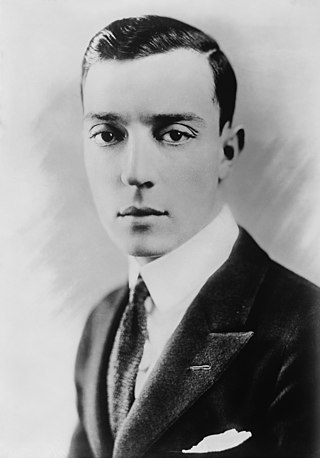
Joseph Frank "Buster" Keaton was an American actor, comedian and film director. He is best known for his silent films during the 1920s, in which he performed physical comedy and stunts with a stoic, deadpan expression that became his trademark and earned him the nickname "The Great Stone Face". Critic Roger Ebert wrote of Keaton's "extraordinary period from 1920 to 1929" when he "worked without interruption" as having made him "the greatest actor-director in the history of the movies". In 1996, Entertainment Weekly recognized Keaton as the seventh-greatest film director. and in 1999 the American Film Institute ranked him as the 21st-greatest male star of classic Hollywood cinema.
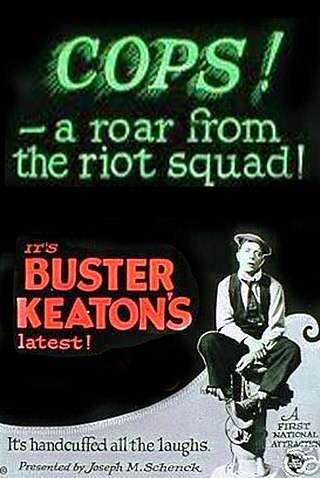
Cops is a 1922 American two-reel silent comedy film about a young man who accidentally gets on the bad side of the entire Los Angeles Police Department during a parade and is chased all over town. It was written and directed by Edward F. Cline and Keaton. This very Kafka-esque film was filmed during the rape-and-murder trial of Fatty Arbuckle, a circumstance that may have influenced the short's tone of hopeless ensnarement.

Roscoe Conkling "Fatty" Arbuckle was an American silent film actor, director, and screenwriter. He started at the Selig Polyscope Company and eventually moved to Keystone Studios, where he worked with Mabel Normand and Harold Lloyd as well as with his nephew, Al St. John. He also mentored Charlie Chaplin, Monty Banks and Bob Hope, and brought vaudeville star Buster Keaton into the movie business. Arbuckle was one of the most popular silent stars of the 1910s and one of the highest-paid actors in Hollywood, signing a contract in 1920 with Paramount Pictures for $1,000,000 a year.

Edward Francis Cline was an American screenwriter, actor, writer and director best known for his work with comedians W.C. Fields and Buster Keaton. He was born in Kenosha, Wisconsin and died in Hollywood, California.
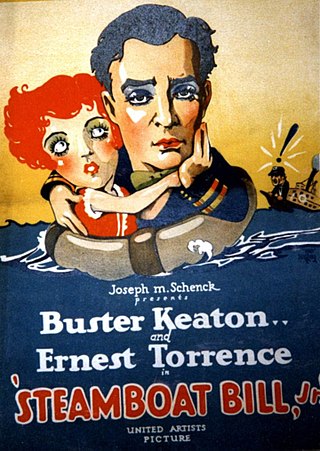
Steamboat Bill, Jr. is a 1928 silent comedy film starring Buster Keaton. Released by United Artists, the film is the final product of Keaton's independent production team and set of gag writers.

Educational Pictures, also known as Educational Film Exchanges, Inc. or Educational Films Corporation of America, was an American film production and film distribution company founded in 1916 by Earle Hammons (1882–1962). Educational primarily distributed short subjects; it is best known for its series of comedies starring Buster Keaton (1934–37) and the earliest screen appearances of Shirley Temple (1932–34). The company ceased production in 1938, and finally closed in 1940 when its film library was sold at auction.

One Week is a 1920 American two-reel silent comedy film starring Buster Keaton, the first independent film production he released on his own. The film was written and directed by Keaton and Edward F. Cline, and runs for 19 minutes. Sybil Seely co-stars. The film contains a large number of innovative visual gags largely pertaining to either the house or to ladders.

The Navigator is a 1924 American comedy film directed by and starring Buster Keaton. The film was written by Clyde Bruckman and co-directed by Donald Crisp. In 2018, the film was selected for preservation in the United States National Film Registry by the Library of Congress as being "culturally, historically, or aesthetically significant."

The Love Nest is a 1923 American short comedy silent film written and directed by and starring Buster Keaton. It is his 19th and final film at Buster Keaton Productions and last silent short film.
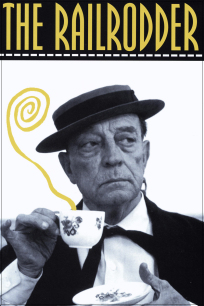
The Railrodder is a 1965 short comedy film starring Buster Keaton in one of his final film roles, directed and written by Gerald Potterton and produced by the National Film Board of Canada (NFB). A 25-minute comedic travelogue of Canada, The Railrodder was also Keaton's final silent film, as the film contains no dialogue and all sound effects are overdubbed.
Ted Okuda is an American non-fiction author and film historian. He has many books and magazine features to his credit, under his own name and in collaboration with others.
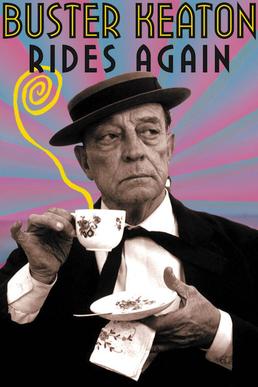
Buster Keaton Rides Again is a 55-minute 1965 documentary film directed by John Spotton and narrated by Michael Kane. The film is a behind-the-scenes documentary shot while Buster Keaton's film The Railrodder (1965), was being produced. Although it is a production documentary, the film is actually longer than The Railrodder, which was only 24 minutes long. Both films were produced by the National Film Board of Canada (NFB). A French version of Buster Keaton Rides Again, Avec Buster Keaton was also released.

The Rough House is a 1917 American two-reel silent comedy film written by, directed by, and starring both Roscoe "Fatty" Arbuckle and Buster Keaton. The Rough House was Keaton's first film as a director.

The Frozen North is a 1922 American short comedy film directed by and starring Buster Keaton. The film is a parody of early western films, especially those of William S. Hart. The film was written by Keaton and Edward F. Cline. The film runs for around 17 minutes. Sybil Seely and Bonnie Hill co-star in the film.

Sybil Seely was a silent film actress who worked with the well known silent film comedy actor Buster Keaton. She was credited in some of her films as Sibye Trevilla.

Raymond Rohauer was an American film collector and distributor.

Elgin Lessley was an American hand-crank cameraman of the silent film era—a period of filmmaking when virtually all special effects work had to be produced inside the camera during filming. Though Lessley worked earlier with Roscoe "Fatty" Arbuckle, and later with Harry Langdon, he is best known for the groundbreaking effects he produced with Buster Keaton, who dubbed him "the human metronome" for his ability to crank consistently at any requested speed.

Frank D. Williams was a pioneering cinematographer who was active in the early days of the motion picture industry. He developed and patented the traveling matte shot.
The International Buster Keaton Society Inc.— a.k.a. "The Damfinos"—is the official educational organization dedicated to comedy film producer-director-writer-actor-stuntman Buster Keaton.

Fred Gabourie was a technical director and department head.


















